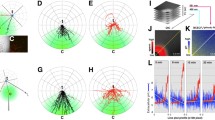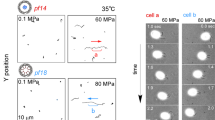Summary
Flagellar waveforms have been studied during spontaneous stopping and starting transients of sperm of the sea urchinTripneustes gratilla reactivated at pH 7.7 with 1mM MgATP2− in the presence of 15 μm free Ca2+. A stopping transient begins abruptly when a reverse bend fails to be initiated at the proper time, and leaves the last-formed principal bend remaining stationary near the flagellar base while the more distal principal and reverse bends all propagate normally to the tip. After a brief quiescent interval lasting 0.5–4 beat periods, the starting transient begins with initiation of a new reverse bend that then propagates nearly normally to the tip. The total duration of stopping and starting transients is about 1.5 beat periods each, much shorter than the duration of the corresponding transients in the flagella of live sperm studied previously. The brief duration of reactivated transients is interpreted to indicate that the response time of the mechanochemical mechanisms regulating the tubule sliding associated with bend propagation is significantly faster than that of the mechanism responsible for Ca2+-induced asymmetry and quiescence.
Similar content being viewed by others
References
Brokaw, C. J. (1982) Models for oscillation and bend propagation by flagella. InProkaryotic and Eukaryotic Flagella. Society of Experimental Biology Symposium, No. XXXV (edited byAmos, W. B. andDuckett, J. G.), pp. 313–38. Cambridge: Cambridge University Press.
Gibbons, B. H. (1980) Intermittent swimming in live sea urchin sperm.J. Cell Biol. 84, 1–12.
Gibbons, B. H. &Gibbons, I. R. (1980a) Calcium-induced quiescence in reactivated sea urchin sperm.J. Cell Biol. 84, 13–27.
Gibbons, I. R. &Gibbons, B. H. (1980b) Transient flagellar waveforms during intermittent swimming in sea urchin sperm. I. Wave parameters.J. Musc. Res. Cell Motility 1, 31–59.
Gibbons, I. R. (1981) Transient flagellar waveforms during intermittent swimming in sea urchin sperm. II. Analysis of tubule sliding.J. Musc. Res. Cell Motility 2, 83–130.
Gibbons, I. R. (1982) Sliding and bending in sea urchin sperm flagella. InProkaryotic and Eukaryotic Flagella, Society of Experimental Biology Symposium, No. XXXV (edited byAmos, W. B. andDuckett, J. G.), pp. 226–287. Cambridge: Cambridge University Press.
Goldstein, S. F. (1969) Irradiation of sperm tails by laser microbeam.J. exp. Biol. 51, 431–41.
Goldstein, S. F. (1976) Form of developing bends in reactivated sperm flagella.J. exp. Biol. 64, 173–84.
Gray, J. (1955) The movement of sea urchin spermatozoan.J. exp. Biol. 32, 775–801.
Okuno, M. &Hiramoto, Y. (1976) Mechanical stimulation of starfish sperm flagella.J. exp. Biol. 65, 401–13.
Rikmenspoel, R. (1978) Movement of sea urchin sperm flagella.J. Cell Biol. 76, 310–22.
Author information
Authors and Affiliations
Rights and permissions
About this article
Cite this article
Gibbons, I.R. Transient flagellar waveforms in reactivated sea urchin sperm. J Muscle Res Cell Motil 7, 245–250 (1986). https://doi.org/10.1007/BF01753557
Received:
Revised:
Issue Date:
DOI: https://doi.org/10.1007/BF01753557




